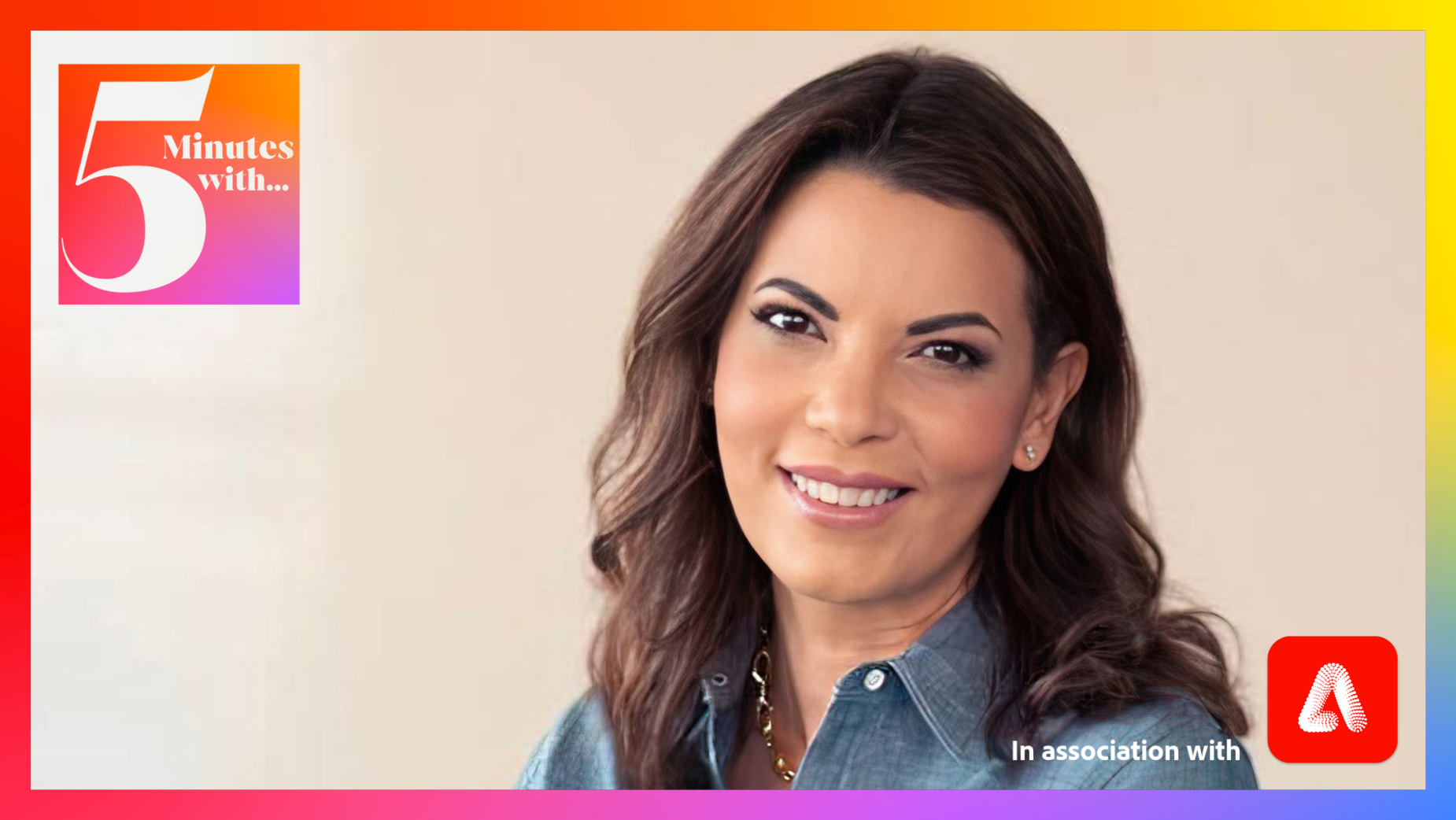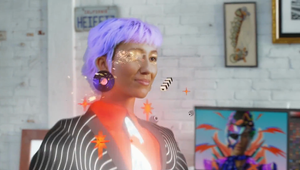
5 Minutes with… Michelle Taite

Adobe Firefly is a proud supporter of LBB. As part of the sponsorship of the ‘5 Minutes with…’ channel, we spend time with some of the most innovative and creative minds in the industry.
Today, we chat to Michelle Taite, who, as CMO of Intuit Mailchimp, is in the unique position of "marketing to marketers".
Michelle is responsible for the platform's end-to-end brand, acquisition, performance, product, and lifecycle marketing activities globally. She also oversees Wink, Mailchimp's highly respected in-house agency, which was recognised as In-house Agency of the Year in 2023 by AdAge.
LBB's Addison Capper speaks with Michelle about the importance of unity in marketing, spurred on by the recent Olympic Games, and opportunities abound for personalisation and AI - and why they're ever more important within hostile political environments.
LBB> You recently mentioned on LinkedIn the unifying role that the Paris Olympics have had so far. What inspired you to write that post? And how important is unity when it comes to marketing?
Michelle> As marketers, we’re looking to break through: to get audiences' attention and create meaningful connections in the process. So in a world of constant distraction and noise, it was amazing to see everyone around the world stop, tune in, and unite around a cultural moment that brought excellence - and in many cases, excellence through teamwork - to the forefront. I’m a big believer in craft and connection super charging each other, and this showed exactly that. People love competition. They want to cheer for something, and it's a thrill to witness and to celebrate excellence. But for many people, it's the unity people feel during the Olympics that makes the games so noteworthy. And what is unity if not a form of connection?
In our lives, we are presented with much smaller opportunities to connect with people every day. When you're lost and a stranger gives you directions, that's connection. When you chat about a TV show or share a gripe with your neighbour about the weather, that can be connection too. In marketing, the person on the receiving end of your campaign is just that – a person. And as AI tools advance our ability to personalise campaigns and deliver what customers actually want, marketers have an ability to connect on the individual level like never before.
LBB> You've worked in marketing/brand management since around 2010. What are some other tried and tested marketing techniques and themes that have stuck with you the whole time?
Michelle> Marketing, in my experience, has always centred around connection. And meaningful connections share three commonalities: soulful subjectivity, sincere personalisation, and shared courage. Soulful subjectivity is about knowing who you are - your character, values, tone, feel, and intent - and squaring that with who your customers are in order to craft a subjective understanding of one another. Sincere personalisation is about thoughtfully tailoring your offerings to deliver value to all parties. And shared courage is often necessary to accomplish the first two items; they both rely on acts that often sit at the intersection of fear and confidence. Understanding and exploring these elements has been foundational to my career, and it's hard to imagine great marketing ever truly leaving any of them behind.
LBB> On the flip side, what is something really new and exciting that is taking up a lot of your brain space right now?
Michelle> It is really incredible how much AI is revolutionising marketers' capacity to personalise. And at Mailchimp, we've had a front row seat. Revenue intelligence for Mailchimp, a solution we announced this summer, uses AI that’s trained on Mailchimp marketing performance data points as well as financial metrics from QuickBooks and third-party commerce integrations to proactively point out where marketers are missing opportunities. That can include creating smarter segments - new customers, potential customers, VIPs - as well as recommending optimal discounts or predicting the best times to reach out. The technology can even go a step further to actually draft on-brand creative assets, allowing time-strapped marketers to move on these recommendations efficiently.
I'm really excited about the creativity we're going to see from brands of all sizes now that so much time-consuming analysis and versioning work can be offloaded so seamlessly.
LBB> What are your more general thoughts on the role of AI when it comes to marketing and the industry's adoption so far?
Michelle> I think of AI as an equaliser and an accelerator for marketing teams. When done right, working with predictive and generative AI can be a really collaborative experience. During a brainstorming session, prompting an image generator together can rally the team around a shared vision, helping you quickly build on the best ideas and leave behind the ones that don't quite work. Predictive analytics can anticipate your customers' questions or pain points, allowing your team to build better solutions. Even something as simple as an AI-powered notetaker can drive efficiency. Experimenting with the latest capabilities and sharing what we learn with our teammates can unlock the kind of compounding results that give way to significant competitive advantage.
LBB> How are those thoughts informing the way you approach the way you are marketing Mailchimp and its products?
Michelle> Mailchimp is in the unique position of marketing to marketers, so it's really important that we start with an understanding of where they are and where they want to be – and how our product can help them address the gap. Data informs our approach at every step. For example, our research showed that while advanced marketers using Mailchimp may have a handle on some personalised strategies, like abandoned cart automations, they struggle to know what to do with most of their first-party data. So projects like the ‘Clustomer’ campaign centre around those amorphous clusters of customer data and how to untangle them.
We also know that 88% of marketers believe their marketing organisation must increase its use of automation and AI to meet customer expectations and stay competitive, but half of marketers say inadequate AI adoption is holding their organisation back from reaching their goals. So when it comes to marketing our AI features, it's important to make it clear that they're easy to adopt and the benefits can be realised relatively quickly.
LBB> Mailchimp recently launched the ‘Science of Loyalty’ report, which explored the psychology of loyalty. In your eyes, what kind of strategies can marketers deploy to rebuild a connection with consumers?
Michelee> One of the most actionable takeaways - although definitely not always the easiest to get right - was the idea of prioritising ‘smooth selling’. 97% of repeat purchasers said their preferred brand makes it quick and easy to purchase. Brands must remove obstacles that could disrupt customers' shopping journeys, and that often starts with marketers taking measures to make the purchase decision easier. Personalised recommendations, for example, can remove the overwhelm of too much choice, allowing for a more streamlined experience. And tapping into your customers' routines can be especially powerful: 35% of those who purchase on a daily or weekly basis said their preferred brand was the only one they’d consider, versus 22% among those purchasing monthly or less.
LBB> The general environment in many countries right now is quite volatile, with controversial elections happening or having happened. How does this impact those strategies?
Michelle> The digital landscape in particular can be incredibly overwhelming right now. It's all the more reason for marketers to be thoughtful about the individual experience. Our research has shown that connection with customers can be as important as free shipping when it comes to driving purchases – even as consumers seek cheaper alternatives during the cost-of-living crisis. If the only way you connect with your audience is through a one-size-fits-all message, it's going to get lost. In fact, nearly half (45%) of consumers believe that the future of personalisation will mean they won’t need to search for products and services – rather, that their desired purchases will be coming to them. Using predictive analytics to anticipate customer behaviour, marketers can side-step the chaos, showing up where and when their customers actually want to see them. It’s a strategy that becomes all the more crucial in a volatile environment.
LBB> Mailchimp has a really strong in-house agency in Wink. What is your relationship like with the team there? How do you feel it is similar or different to a more traditional agency x client relationship?
Michelle> It takes courage to deliver bold creative work. A certain amount of risk-taking is necessary, and people don't take risks when they don't feel comfortable at work. So while there are a lot of ingredients in our secret sauce, it starts with fostering psychological safety on our teams. That can be as simple as taking time to let people get to know one another – starting meetings with a personal question, or sounding off on Slack about our weekends. We celebrate life moments and we celebrate professional moments. We have fun. But at the same time, we have very high expectations. #BeatOurBest is the hashtag we use across our marketing team, and we really mean it. We want to be the best together, but more immediately we want to be better than we were yesterday. And that requires humility and curiosity. It requires us to ask questions and, especially as leaders, to admit that we don't know all of the answers. Building that trust with one another allows us to experiment ambitiously, learn from our failures, and continuously build on our successes.
LBB> How did you end up working in marketing in the first place? Was it planned or more a happy accident?
Michelle> It was more of a happy accident. I started out as a product designer, and curiosity is really what led me to marketing. I was always fascinated by customer insights and the idea of problem solving through data; it was something that followed me through many disparate phases of my career. How do you create new experiences for people without necessarily requiring more money or more space? How do you innovate? The more I learned about commercialisation, the more I fell in love with marketing and the art and science of connection building.
LBB> In your free time, what do you love to get up to?
Michelle> Well, I have two boys, so lots of Legos. I also love singing jazz and spending time at museums.















